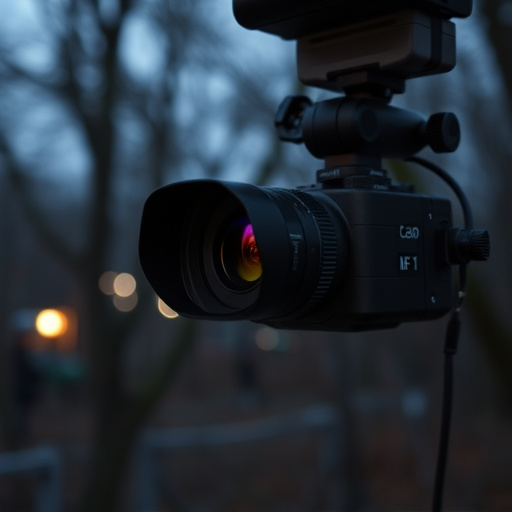Undetectable wireless security cameras provide discreet monitoring solutions for personal and professional use, but raise ethical and legal concerns due to privacy regulations. Their advanced features like motion detection and night vision make them effective while their hidden nature stirs privacy debates. Effective counter-surveillance measures include inspections, specialized equipment, and proactive safety steps, as the battle between technology and privacy continues.
In today’s digital era, covert recording equipment has become a ubiquitous tool for surveillance. Understanding and navigating these hidden devices is crucial for both privacy advocates and security professionals. This article delves into the world of covert recording, focusing on undetectable wireless security cameras as well as effective placement strategies and detection methods. By exploring these aspects, readers will gain valuable insights into protecting their privacy and countering clandestine surveillance attempts.
- Understanding Covert Recording Equipment
- Wireless Security Cameras: The Undetectable Advantage
- Placement Strategies for Discreet Surveillance
- Detecting and Countering Hidden Cameras
Understanding Covert Recording Equipment
Covert recording equipment, often referred to as hidden cameras or undetectable wireless security cameras, is designed to operate discreetly, making them an attractive yet controversial tool for surveillance. These devices can range from small, easily camouflaged cameras disguised as everyday objects like pens or power outlets to more sophisticated gadgets with advanced features such as motion detection and night vision. The allure lies in their ability to provide unnoticeable monitoring, appealing to both personal and professional users seeking security or evidence collection without raising suspicion.
However, the very nature of covert recording raises ethical concerns and legal implications. Many countries have strict regulations regarding privacy and the use of hidden cameras, with laws varying based on consent, location, and purpose. Understanding these nuances is crucial when considering the placement and detection of such equipment to ensure compliance and respect for personal privacy.
Wireless Security Cameras: The Undetectable Advantage
Wireless Security Cameras offer a subtle yet powerful solution for surveillance, especially in situations where detection must be kept to a minimum. Their design eliminates the need for unsightly cables and physical connections, making them nearly invisible to potential intruders. This advantage is particularly valuable in public spaces, offices, or homes where the presence of traditional security cameras could raise suspicion or alert would-be criminals.
The ‘undetectable’ nature of these wireless cameras doesn’t compromise their effectiveness. Advanced wireless technology ensures they provide clear and consistent footage, often with features like motion detection, night vision, and remote access. This allows for discreet monitoring while maintaining a high level of security, making them an appealing choice for those seeking comprehensive protection without sacrificing privacy or aesthetics.
Placement Strategies for Discreet Surveillance
When it comes to covert recording equipment placement, the goal is to remain undetected while capturing essential footage. One effective strategy involves utilizing undetectable wireless security cameras that blend seamlessly into their surroundings. These advanced devices are designed with minimal visual impact in mind, making them ideal for discreet surveillance. Placement often entails strategic positioning near potential points of interest, such as doorways, windows, or areas where privacy concerns exist.
Professionals employ techniques like mounting cameras on ceilings or walls, ensuring they have unobstructed lines of sight while remaining out of view. Additionally, employing reflective surfaces or hidden compartments can further enhance the secrecy. The key is to prioritize positioning that allows for clear audio and video capture without raising suspicion, making these undetectable wireless security cameras a game-changer in covert surveillance operations.
Detecting and Countering Hidden Cameras
Hidden cameras, often referred to as covert recording devices, have become increasingly sophisticated and harder to detect. With the advent of undetectable wireless security cameras, criminals and spies can record sensitive information with impunity. However, awareness is a robust defense mechanism against such threats. Security professionals recommend regular visual inspections, particularly in areas prone to surveillance, like offices, homes, or public spaces. Using specialized equipment, such as infrared cameras and UV lights, can help identify hidden lenses that are invisible to the naked eye.
Additionally, staying informed about the latest counter-surveillance technologies is paramount. For instance, reflective surface treatments for windows and walls can obscure camera views, while signal jammers can disrupt wireless signals, rendering undetectable cameras less effective. It’s a constant cat-and-mouse game between technology creators and those seeking to invade privacy, highlighting the need for proactive security measures and staying ahead of evolving surveillance techniques.
In the realm of surveillance, understanding and countering covert recording equipment has become increasingly vital. By exploring strategies such as wireless security cameras that offer an undetectable advantage and implementing discreet placement techniques, individuals and organizations can enhance their privacy protection. Additionally, staying informed about advanced detection methods ensures a proactive approach to safeguarding sensitive information from hidden threats. Embracing these measures is crucial in today’s digital era, where privacy and security are paramount.
